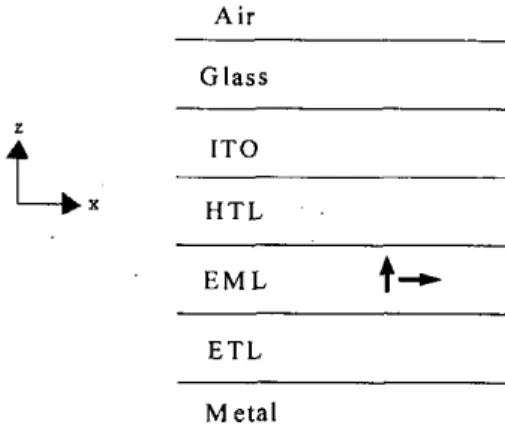W1
A-(
1 4 ) 4
SIMULATIONS ON THE RADIATION CHARACTERISTICS OF
AN ORGANIC LIGHT-EMITTING DIODE
Hung-Chi Chen”, Jim-Haw
Leea, Yean-Woei Kianga, C. C. Yanga, and Yih Changb
aGraduate Institute of Communication Engineering, Graduate Institute of Electro-Optical
Engineering, and Department of Electrical Engineering, National Taiwan University,
I , Roosevelt Road, Section
4,Taipei, Taiwan
(phone) 886-2-2363525
1(fax) 886-2-23652637 (e-mail) ywkiang@ew.ee.ntu.edu.hv
bRiTdisplay Corporation, 12, Kuanfu N. Rd., Hsinchu, Industrial Park, Taiwan
Abstract-The radiation angle a n d wavelength dependencies of electroluminescence from a multi-layer organic light-emitting diode (OLED) are numerically investigated. The numerical d@culry arising from the large thickness of the glass layer in the OLED is carefully overcome.
Based on the general electromagnetic theory, a rigorous numerical method is developed for analyzing the radiation characteristics of an OLED. The device of interest is a typical seven-layer structure shown schematically in Fig. 1. For calculating the radiation from dipole sources embedded in the emission layer (EML), we introduce the electric Hertzian vector potential, which, in each layer, can be expressed as an integral with respect to the radial wavenumber. To calculate the radiation field in the air region, the saddle-point method is usually used to perform the integration. However, severe interference phenomenon arising from the large thickness of the glass layer results in the difficulty of separating the slowly-varying term from the fast-varying one. To overcome this difficult);, we first remove the air region and assume the glass layer to be infinitely thick. For the new six-layer structure, we safely employ the saddle-point method to determine the mathematical expression of the radiation field Eglo,, at the original interface between the air region and the glass layer. Then the air region is put back upon the glass layer, and the glass layer is recovered to the original thickness. Now for the glass layer, there are an air region above it and a multiplayer structure composed of indium tin oxide (ITO), hole-transport layer (HTL), EML, electron-transport layer (ETL) and metal region below it. Then E,,*,, , acting as an incident field in the glass layer, will propagate in glass layer subjected to multiple reflections and transmissions. Finally, we can determine the effective transmission coefficient for E,,,,, to transmit to the air region. We assume that the dipole source is of a finite bandwidth (say, 0.5nm), and the resultant radiation field is obtained by coherently averaging the fields over that range ofwavelengths. For simulation, typical thickness and refractive index for each layer are chosen as follows: glass (850)” 1.48); IT0 (0.085pm, 1.8); HTL (0.16pm, 1.7); EML ( 0 . 0 3 ~ ~ 1.8); ETL (O.IZpm, 1.7). Here, IO’ dipole sources randomly oriented in the emission layer are included for each simulation. Assuming that the photoluminescence emission spectrum is peaked at 0.55pm with half-maximum points at 0.52pm and 0.61pm, we can calculate the EL intensity spectrum at various view angles. Shown in Fig. 2 is the EL intensity spectrum in the normal viewing direction (at O=O) for different thickness of HTL. It is also found that varying the HTL thickness has less influence on the total radiant power than on the angular emission pattern.
A i r G l a s s
i
I T 0 H T L E M L+-
E T L M eta1Fig. 1 Schematic structure of an OLED
8 3 0 4 0 5 O B 0 7
Wavelength (pm)
Fig. 2 Electroluminescence intensity spectrum (atO=O)
for different thickness of HTL, from 10’randomly oriented dipoles.
0-7803-7766-41031$17.00 02003 IIIBE
